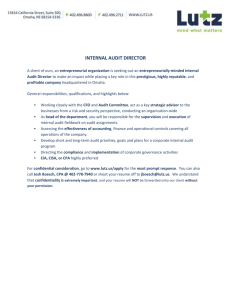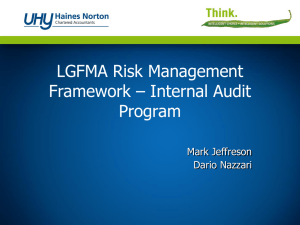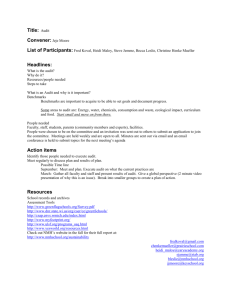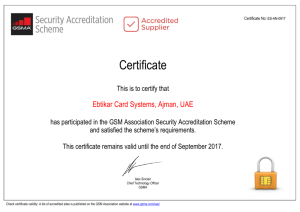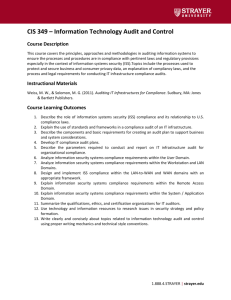Risk Assessment Standards - Rob Churchman, John Montoro and
advertisement
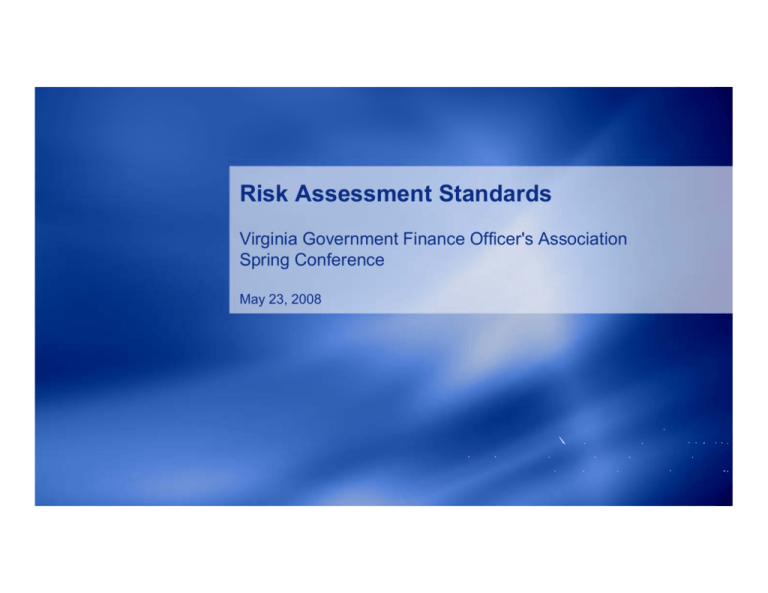
Risk Assessment Standards Virginia Government Finance Officer's Association Spring Conference M 23, May 23 2008 P R J M P C P C H H B T KMPG LLP H M AICPA Presentation Objectives 1. Discuss background of risk assessment standards 2 Illustrate the application of the audit risk process 2. 3. Highlight significant changes 1 Risk Assessment Standards 1. SAS No. 104, Amendment to Statement on Auditing Standards No. 1, Codification of Auditing Standards and Procedures; 2. SAS No. 105, Amendment to Statement on Auditing Standards No. 95, Generally Accepted Auditing Standards; 3. SAS No. 106, Audit Evidence; 4. SAS No. 107, Audit Risk and Materiality in Conducting an Audit; 5. SAS No. 108, Planning and Supervision; 6 SAS No 6. No. 109 109, Understanding the Entity and Its Environment and Assessing the Risks of Material Misstatement; 7. SAS No. 110, Performing Audit Procedures in Response to Assessed Risks and Evaluating g the Audit Evidence Obtained;; and 8. SAS No. 111, Amendment to Statement on Auditing Standards No. 39, Audit Sampling 2 Background • Objective is to guide auditors to areas of greatest risk whether caused by error or fraud • • Issued in March 2006 Effective for periods beginning after December 15, 2006 3 Significant Changes to Existing Practices 1. Identify and assess the risks of material misstatements 2 Design and perform tailored further audit procedures responsive to assessed 2. risks 3. Provide linkage between assessed risks and audit responses 4 Overview of Risk Assessment Process Gain an understanding of the entityy Perform risk assessment procedures p Assess the risks of material misstatement Overall financial statement Level Assertion Level Overall Responses Further audit procedures Evaluate Sufficiency of Audit Evidence 5 SAS 104 – Amendment to SAS 1 Due Professional Care Key Provisions Difference from Previous • Defines reasonable assurance as “high high • Clarifies meaning of reasonable level of assurance assurance 6 SAS 105 – Amendment to SAS 95 GAAS Key Provisions Difference from Previous • Expands p scope p of understanding g in 2nd • Understandingg of entityy to be ppart of fieldwork standard from “internal control” to the “entity and its environment, including internal control.” audit planning with emphasis that I/C was primarily part of planning. Now that understanding is part of assessing risk of material misstatement, misstatement understanding ultimately supports the opinion on f/s 7 SAS 105 – Amendment to SAS 95 GAAS (continued) Key Provisions Difference from Previous • Qualityy and depth p of understanding g is • Emphasizes p the link between emphasized by change for “planning” to “assessing the risks” understanding, assessing risks, and design of audit procedures. “Generic” audit programs may not be appropriate. • “Further audit procedures” (test of controls + substantive tests) replaces “tests to be performed” • “Audit Audit evidence evidence” replaces “evidential evidential matter” 8 SAS 106 – Audit Evidence Key Provisions Difference from Previous • Audit evidence = “all all information used • No definition of audit evidence • “Sufficient, appropriate audit evidence” by the auditor in arriving at conclusions on which opinion is based.” • Recategorizes assertions; expands p presentation and disclosure ((P&D)) guidance; and describes how to use assertions to assess risk and design procedures replaces “sufficient, competent evidence” • Recategorizes assertions to add clarity • P&D assertion expanded and includes assertion that information in disclosures should be “expressed clearly” 9 SAS 106 – Audit Evidence (continued) Key Provisions Difference from Previous • Defines relevant assertions as those • Term “relevant assertions” is new that have a meaningful bearing on account fairness • Provides additional guidance on reliability of various kinds of audit evidence • Expands guidance discussion of the competence of evidential matter and how different types may provide more or less valid evidence 10 SAS 106 – Audit Evidence (continued) Key Provisions Difference from Previous • Identifies “risk assessment pprocedures” • “RAP” RAP which are necessary to provide a (RAP) as audit procedures performed on all audits • Obtain understanding of entity & en ironment including environment, incl ding internal controls • Assess risks of material misstatements at f/s and assertion levels basis for assessing risks of material misstatements. Results of RAP, with results of further audit procedures, provide audit evidence to support opinion on f/s 1 SAS 106 – Audit Evidence (continued) Key Provisions Difference from Previous • Describes types yp of audit p procedures • RAP include: that may be used alone or in combination as RAP, tests of controls, or substantive procedures • Guidance on uses and limitations of inquiry • • • Inquiries Analytical procedures Observation and inspection • Inquiry alone is not sufficient to evaluate the design of I/C and to determine whether implemented 12 SAS 107 – Audit Risk & Materiality Key Provisions Difference from Previous • Must consider audit risk and determine • Previous “should consider” – now “must materiality level • • • • Determine extent and nature of RAP Identify & assess risk of misstatement consider” • Explicit that audit risk and materiality are used to identify and assess risks Determine nature, timing, & extent Evaluate whether f/s are presented fairly with GAAP 13 SAS 107 – Audit Risk & Materiality (continued) Key Provisions Difference from Previous • Risk of material misstatement ((RMM)) = • Consistent use of “risk of material assessment of inherent + control risks • Auditor should assess RMM as basis for further audit procedures. Risk assessment is a judgment, auditor should have appropriate basis • Assessed risks and basis should be misstatement” • Auditor should have and document basis for audit approach • Eliminates auditor to assess control risk “at at the maximum maximum” without a basis for assessment documented 14 SAS 107 – Audit Risk & Materiality (continued) Key Provisions Difference from Previous • Accumulate all known & likelyy • Additional gguidance on communicatingg misstatements (not trivial), and communicate them to management • Request management to respond when misstatements i t t t are identified id tifi d to management • Additional specific guidance on how to determine threshold for accumulating misstatements • Specific guidance for appropriate auditors responses 15 SAS 108 – Planning & Supervision Key Provisions • Guidance on • • • • • • • • • Appointment of auditor Establishing understanding with the client Preliminary activities Overall audit strategy Audit plan Involvement of specialists Use of IT specialists Initial audit considerations Supervision of assistants Difference from Previous • Guidance consolidated from existingg standards • New guidance on: • Overall audit strategy gy – broad approach pp to how audit to be conducted (considering scope, deadlines, recent developments) • Audit plan – More detailed than strategy, describes nature,, timing, g, and extent of risk assessment and further audit procedures • Establish written understanding with client regarding services for each engagement 16 SAS 109 – Understanding Entity & Environment and Assessing Risks Key Provisions Difference from Previous • Describes audit pprocedures to • Perform RAP ((inquiries, q , observation,, obtain understanding of the entity and its environment, including I/C analytical) to gather info and gain understanding. Previous standards did not describe procedures to be used. • Information may be provided by variety of sources, including prior audit knowledge (provided certain conditions met), and results of client accepted p and continued p procedures. • Describes imitations of inquiry. 17 SAS 109 – Understanding Entity & Environment and Assessing Risks (continued) Key Provisions Difference from Previous • Audit team to discuss susceptibility p y of • Requires q brainstorming g session to f/s to misstatements discuss risks of material misstatements (can be performed with fraud brainstorming) 18 SAS 109 – Understanding Entity & Environment and Assessing Risks (continued) Key Provisions Difference from Previous • Purpose of obtaining understanding is • Directly links the understanding with the to identify and assess RMM and design & perform audit procedures responsive to assessed risk. assessment of risk and design of further audit procedures. 19 SAS 109 – Understanding Entity & Environment and Assessing Risks (continued) Key Provisions Difference from Previous • Auditor should assess RMM at both • Previous – concept p of assessing g risk at f/s and relevant assertion levels f/s level • Now – Expanded, explicit guidance • Directs auditor to determine how risks at f/s level may result in risks at assertion level 20 SAS 109 – Understanding Entity & Environment and Assessing Risks (continued) Key Provisions Difference from Previous • How to evaluate design g of entity’s y • Previous – understand I/C to pplan audit • Now – understand I/C to assess risks • Previous – understand I/C as part of controls and determine whether adequate and implemented understanding entity • Now – evaluate the design of controls and whether implemented. Involves considering whether control is capable of effectively preventing or detecting and correcting material misstatements. More work than simply gaining understanding of I/C. 21 SAS 109 – Understanding Entity & Environment and Assessing Risks (continued) Key Provisions Difference from Previous • Auditor to consider whether anyy • Previous standard did not include the assessed risks are significant that require special audit consideration or for which substantive procedures alone do not provide sufficient appropriate audit evidence concept of “significant” • Significant risks exist on most engagements • Auditor should gain understanding of I/C and perform substantive procedures on significant risks. Substantive analytical procedures alone are not sufficient sufficient. 2 SAS 109 – Understanding Entity & Environment and Assessing Risks (continued) Key Provisions Difference from Previous • Extensive gguidance on the matters that • Guidance on documentation is should be documented. significantly greater than previous standards. 23 SAS 110 – Performing Audit Procedures in Response to Risks Key Provisions Difference from Previous • Guidance on determiningg overall • Previous gguidance included addressingg responses to address RMM at f/s and the nature of those responses RMM at f/s level and developing overall response in context of audit planning. SAS 110 repositions consideration of risk so assessment is as a result of and in conjunction with performing RAP. • Consider how assessment of risk at f/s level affect individual f/s assertions so may design and perform tailored further audit procedures. • List of possible overall responses to RMM at f/ f/s level l l iis expanded. d d 24 SAS 110 – Performing Audit Procedures in Response to Risks (continued) Key Provisions Difference from Previous • Further audit pprocedures ((test of • Previous – concept p of audit p procedures controls or substantive procedures) should be responsive to assessed RMM at the relevant assertion level responsive to risks embedded in audit risk model. Now – repeated emphasis to provide clear linkage between understanding risks, understanding, risks and design of FAP • Documentation of linkage now required 25 SAS 110 – Performing Audit Procedures in Response to Risks (continued) Key Provisions Difference from Previous • Provides gguidance on matters • Guidance ggreatlyy expanded p and addresses auditor should consider in determining nature, timing, and extent of audit procedures issues not previously included • Nature of procedures is most important in responding to risks • Certain substantive procedures on all engagements • For each material class of transactions, account balance, and disclosure • • Agreeing f/s to accounting records Examining materials JE and other adjustments made in preparing f/s 26 SAS 111 – Amendment to SAS 39 Audit Sampling Key Provisions Difference from Previous • Guidance on auditor jjudgment g about • Enhanced gguidance on tolerable establishing tolerable misstatement for a specific audit procedure and on the application of sampling to tests of controls misstatement. In general, should be less than materiality to allow for aggregation in final assessment. • Ordinarily sample sizes for nonstatistical samples are comparable to samples sizes for effectively designed statistical sample p with the same sampling parameters. 27


